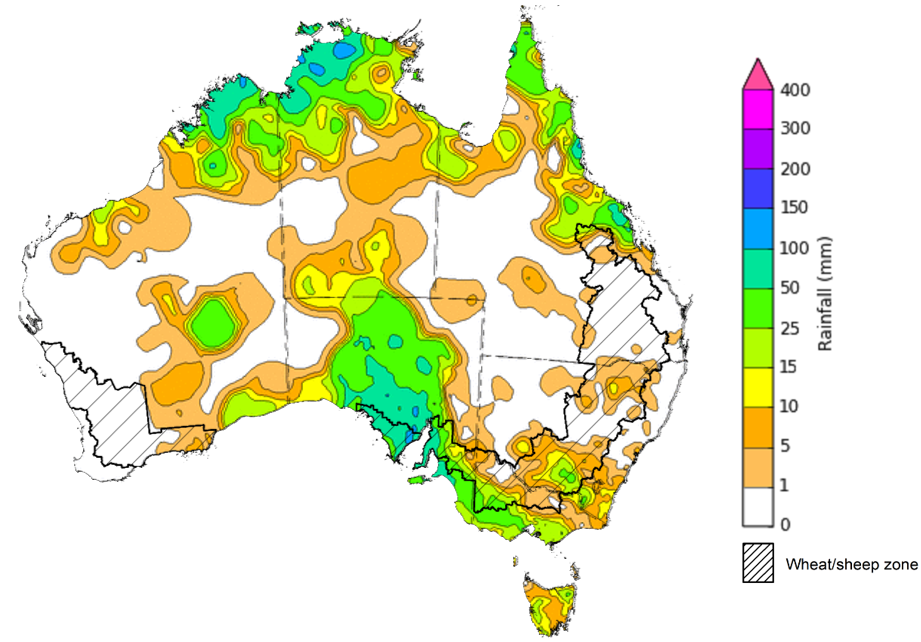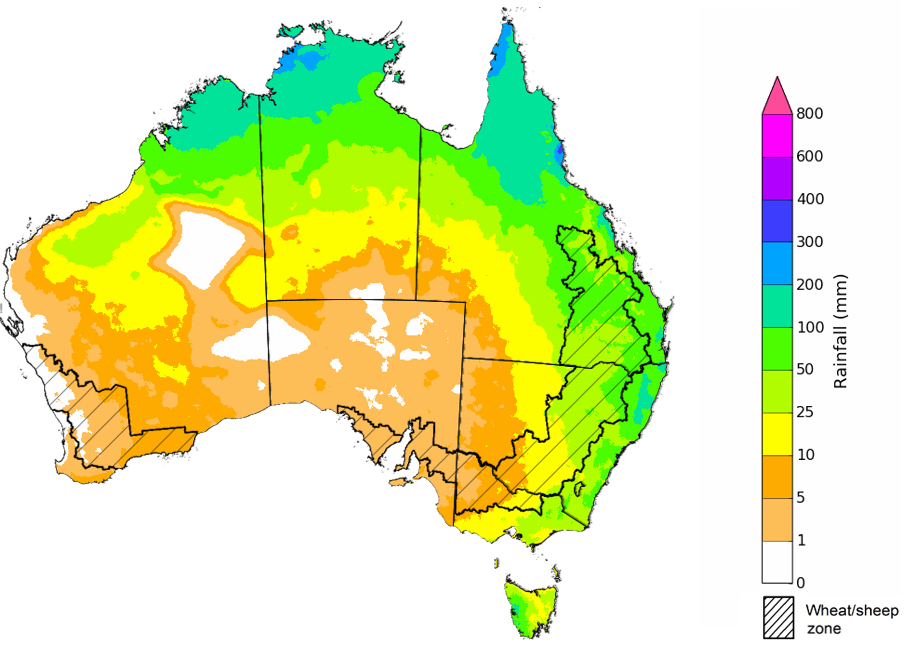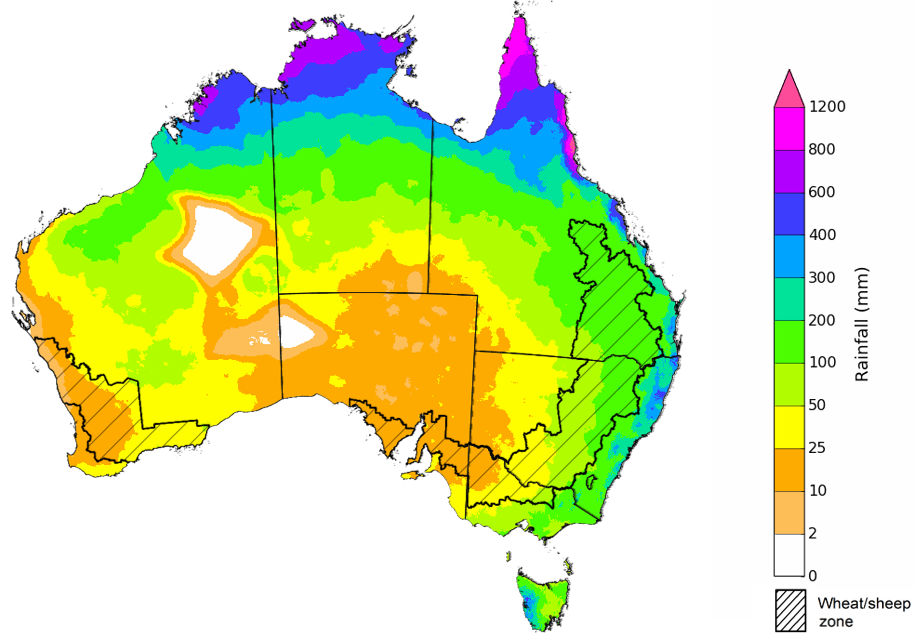Key issues
- For the week ending 13 December 2023, troughs generated rainfall totals of up to 150 millimetres across tropical Northern Australia and South Australia. The movement of Tropical Cyclone Jasper brought rainfall in northeast Queensland.
- Over the coming week, Tropical Cyclone Jasper should weaken to a low but will still result in heavy rain and damaging winds. Troughs will generate showers and storms in Northern Territory and eastern Australia. A cold front will bring showers to Tasmania.
- Rainfall where expected will support development of summer crops and pasture growth, but dry conditions elsewhere will see a decline in soil moisture levels.
- An El Niño and a weakening positive IOD event are still active.
- January to March 2024 rainfall is likely to be around average for much of the eastern cropping areas, but below average across much of the north and west, and parts of southern Australia.
- Water storage levels in the Murray-Darling Basin (MDB) decreased between 7 December 2023 and 14 December 2023 by 56 gigalitres (GL). Current volume of water held in storage is 15 921 GL. This is 8 percent or 1328 GL less than at the same time last year.
- Allocation prices in the Victorian Murray below the Barmah Choke increased from $110 on 7 December 2023 to $140 on 14 December 2023. Prices are lower in the Goulburn-Broken and regions above the Barmah choke due to the binding of the Goulburn intervalley trade limit and the Barmah choke trade constraint.
Climate
For the week ending 13 December 2023, troughs generated rainfall totals of up to 150 millimetres across tropical Northern Australia and South Australia. The movement of Tropical Cyclone Jasper towards northeast Queensland brought rainfall ahead of it making landfall, with significant totals recorded as it crossed the coast on 13 and 14 December.
Across eastern cropping regions, rainfall totals of up to 50 millimetres were recorded in parts of southern New South Wales and Victoria and up to 150 millimetres across South Australia. These falls will have further boosted soil moisture reserves, supporting late season pasture growth. This will likely result in a reduced reliance on supplementary fodder to maintain the production of livestock and livestock products.
Rainfall for the week ending 13 December 2023
Issued: 13/12/2023
Note: The rainfall analyses and associated maps utilise data contained in the Bureau of Meteorology climate database, the Australian Data Archive for Meteorology (ADAM). The analyses are initially produced automatically from real-time data with limited quality control. They are intended to provide a general overview of rainfall across Australia as quickly as possible after the observations are received. For further information go to http://www.bom.gov.au/climate/rainfall/
The timing of Northern Australia rainfall onset is important indicator for seasonal pasture growth and potential livestock production. The rainfall onset gives an indication of the accumulation of at least 50 millimetres of rainfall after 1 September to stimulate plant growth after the northern dry season.
Since 1 September 2023, large areas of northern Australia have received at least 50 millimetres of rainfall. Northern parts of Western Australia, Northern Territory and across large areas of eastern Queensland have recorded onset later than usual. Rainfall in northern Australia for this time of the year is important for pasture and feed availability.
Northern rainfall totals from 1 September
Number of days earlier or later than the long-term average onset date
The climate drivers with the largest potential impact on Australia’s climate patterns are the El Niño–Southern Oscillation (ENSO), Madden-Julian Oscillation (MJO), Indian Ocean Dipole (IOD) and Southern Annular Mode (SAM). These climate drivers are likely to influence pasture growth across southern Australia and the growth and yield prospects for winter crops.
The SAM is currently in neutral phase and is forecast to remain neutral for next fortnight. A neutral SAM is associated with average climate conditions in southern Australia.
A strong pulse of MJO is forecast to be in the western Pacific Ocean in the next fortnight and is expected to result in increased rainfall over northern and central Australia.
An El Niño and a positive IOD event are currently active. The influence of El Niño on Australian rainfall usually reduces during summer, especially across eastern Australia; however, below median rainfall is still often observed in north-east Australia. Additionally, high-impact rainfall events can occur during El Niño years, particularly during October to April when severe storm frequency peaks. Additionally, during El Niño, the onset of the North Australian Monsoon tends to be delayed. The El Niño is expected to persist till early autumn 2024 while positive IOD has weakened and is expected to ease in December 2023.
ENSO and IOD forecast
Issued: 5/12/2023
The Bureau of Meteorology’s latest rainfall outlook for January 2024 indicates that there is a near equal chance of above or below average rainfall for much of Australia. However, below median rainfall is likely to very likely (60 to 80% chance) for Far North Queensland, the north of the Northern Territory and the west of Western Australia. Meanwhile, above average rainfall is more likely for south-east areas of Queensland and north-east New South Wales.
The Bureau of Meteorology’s climate model suggests that for January 2024, there is a 75% chance of rainfall totals being over 25 millimetres across eastern and northern Australia, as well as in Tasmania. Rainfall totals in excess of 100 millimetres are expected across western Tasmania, northern Western Australia and Northern Territory and coastal east.
Across cropping regions, there is a 75% chance of rainfall totals of between 25 and 100 millimetres in New South Wales and Queensland. January rainfall totals are expected to be below 25 millimetres for the remaining cropping regions.
Given the above average rainfall recorded across southern Queensland and north-eastern New South Wales during November and early December, if realised these forecast rainfall totals for January will provide some useful follow-up falls for dryland summer crop production as well as pasture growth across eastern and northern Australia.
Rainfall totals that have a 75% chance of occurring in January 2024
Issued: 14/12/2023
The rainfall outlook for January to March 2024 suggests that there is close to equal chances of above or below median rainfall for much of central and eastern Australia, while below median rainfall is more likely elsewhere. In contrast for parts of northern New South Wales there is an increased chance of receiving above median rainfall.
Across summer cropping regions, there is no strong tendency towards either above or below median rainfall across Queensland and New South Wales. Close to median rainfall in Queensland and northern New South Wales will benefit summer crop production during this period.
Chance of exceeding the median rainfall January to March 2024
Issued: 14/12/2023
The outlook for January to March 2024 suggests there is a 75% chance of rainfall totals between 25 and 200 millimetres across much of Australia. The main exceptions being large areas of South Australia and western and central parts of Western Australia where below 25 millimetres of rainfall are expected. Rainfall totals in excess of 200 millimetres are expected across tropical northern Australia, coastal New South Wales and western Tasmania during this period.
Across summer cropping regions, there is a 75% chance of receiving between 50 and 200 millimetres across New South Wales, Queensland.
If realised, these falls will likely be sufficient to support summer pasture growth across eastern and northern Australia. While the dry start to spring has limited the early planting of summer crops, if realised these forecast falls are likely to be sufficient to support the establishment and growth of crops planted at the end of spring and allow for the additional planting of summer crops in the later planting window during early summer.
Rainfall totals that have a 75% chance of occurring January to March 2024
Issued: 14/12/2023
Over the 8 days to 21 December 2023, Tropical Cyclone Jasper should weaken to a low in north Queensland but will still result in heavy rain and damaging winds. Troughs will generate showers and storms in Northern Territory and eastern Australia. A cold front will bring showers to Tasmania.
While the severity of impact remains unknown, the strong winds and heavy rain from Tropical Cyclone Jasper presents a high risk to the production of horticultural and other high value crops such as sugarcane.
Across cropping regions, rainfall totals up to 50 millimetres are forecast for northern New South Wales and up to 25 millimetres for Queensland. These falls will benefit soil moisture levels for pasture growth and will support summer crops. Little to no rainfall is expected elsewhere, and evaporation due to high temperatures will see soil moisture levels in these areas decline.
Total forecast rainfall for the period 14 December to 2023 to 21 December 2023
Issued 13/12/2023
Note: This rainfall forecast is produced from computer models. As the model outputs are not altered by weather forecasters, it is important to check local forecasts and warnings issued by the Bureau of Meteorology.
Water
Water storages, water markets and water allocations - current week
The Tableau dashboard may not meet accessibility requirements. For information about the contents of these dashboards contact ABARES.
Commodities
Information on weekly price changes in agricultural commodities is now available at the Weekly commodity price update.








